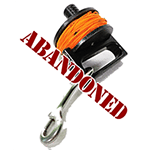A continuous guideline…to where?
 “A continuous guideline to open water…”What does that mean? What should it mean? Regardless of who publishes them, cave diver training materials and standards will have some sort of reference to “maintaining a continuous guideline to open water” — or words to that effect. But what this means depends on who you ask.
“A continuous guideline to open water…”What does that mean? What should it mean? Regardless of who publishes them, cave diver training materials and standards will have some sort of reference to “maintaining a continuous guideline to open water” — or words to that effect. But what this means depends on who you ask.
(more…)



